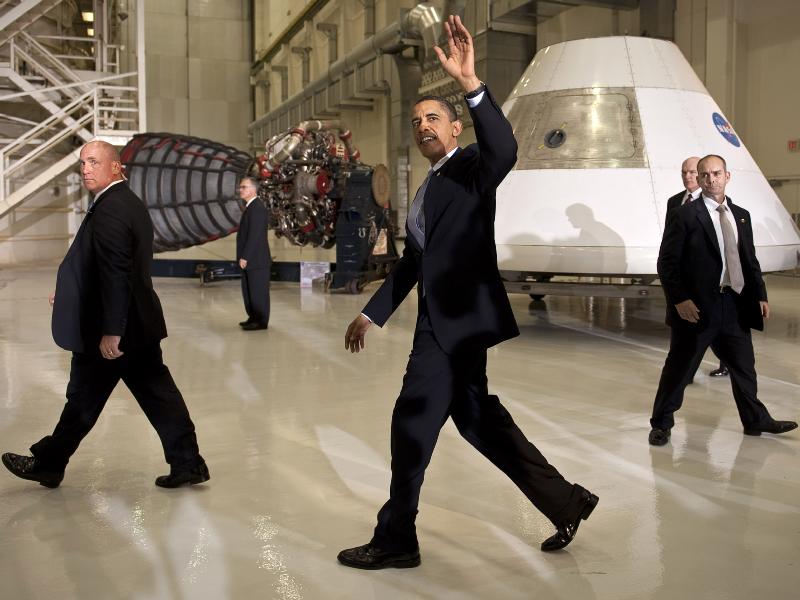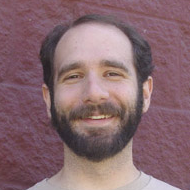 President Obama at the Johnson Space Center, April 15, 2010, with engines and orbital vehicles from the Apollo era in the background. Image: NASA/Bill Ingalls
President Obama at the Johnson Space Center, April 15, 2010, with engines and orbital vehicles from the Apollo era in the background. Image: NASA/Bill IngallsIn his final State of the Union address, delivered on January 13, 2016, President Obama drew an important contrast between today’s politics and a not-so-distant past:
Sixty years ago, when the Russians beat us into space, we didn’t deny Sputnik was up there. We didn’t argue about the science, or shrink our research and development budget. We built a space program almost overnight, and twelve years later, we were walking on the moon.
Indeed, this undersells the analogy. Not only did the Sputnik launch not induce denialists to block all avenues for progress, and not only did it spur investments in research and development that have transformed all of our lives, but it also led to serious upgrades to what today we’d call STEM education.
Federal grants and state science education programs led to the development of major new science textbooks, most particularly the establishment of the Biological Sciences Curriculum Study and its revolutionary textbooks. As the BSCS website explains, these textbooks were funded in part by a grant from the young National Science Foundation to the American Institute for Biological Sciences. The committee took a radical approach:
BSCS believed that the authoritarian tone of biology teaching at the time compromised the investigative nature of science and suffocated the inquisitive spirit of the student. By making students active participants in the scientific process and investigations, BSCS felt students would garner a more complete understanding of science as discipline.
When BSCS set out in 1960 to create new biology programs—three experimental versions of a high school biology course, stressing concepts rather than facts and investigations rather than lectures—it tackled the task with a novel approach. Writers and their families moved into a University of Colorado dormitory for the summer, with rooms on the top floor serving as offices. A high school teacher and a university professor were paired in each office as a team and were assigned to write a chapter or laboratory exercise. After each chapter or exercise was completed, it immediately was mimeographed and distributed to the rest of the writers, who were charged with dissecting the work and finding mistakes. Each team prepared a student textbook, teacher’s guide, and student laboratory book—in about six weeks.
“The idea that you can’t cover everything in a textbook and shouldn’t was radical at this time,” said Jay Barton, BSCS board chairman from 1978 to 1984. “The writers had to decide what they weren’t going to cover as much as what they were.
It’s an idea that’s still radical today, and generates some of the resistance to adoption of the Next Generation Science Standards. The inquiry-driven model is rediscovered by science education reformers every few decades, but has yet fully to replace the “authoritarian” style.
Most importantly for NCSE’s purposes, BSCS’s textbooks brought evolution to the forefront of biology classes. Where publishers had skirted evolution in textbooks since the Scopes era, covering much of the content but avoiding conflict by skipping phrases or concepts (like “evolution” or human ancestry) that might stir up local school boards, BSCS highlighted the issue.
The late Jack Friedman, a long-time member of NCSE’s board, was among the teachers who helped pilot the BSCS. Another early adopter was Susan Epperson, who lent her name to the seminal Epperson v. Arkansas case, in which the Supreme Court overturned the state’s Scopes-era ban on teaching evolution (forty-three years after Scopes was convicted). Epperson, described in contemporary newspapers as a “schoolmarm,” challenged the Arkansas evolution ban based on her school’s adoption of the forthrightly pro-evolution BSCS textbook. The Supreme Court agreed with her argument that the overtly religious nature of the laws rendered them a violation of her First Amendment rights.
In other words, the response to Sputnik was not a mere avoidance of denial, but an active refutation of it—not just in the realm of physics and engineering and aeronautics, but far afield in biology as well. And it came with a broad investment in new research, both applied research necessary to put a crew on the Moon and basic research that led to discoveries unimaginable in 1957.
It is just that spirit of innovation that President Obama invoked as a contrast to climate change denial today, pledging (like about 5 bajillion presidents before him) to find a way to cure cancer. Describing medical research as critical, he added:
We need the same level of commitment when it comes to developing clean energy sources.
Look, if anybody still wants to dispute the science around climate change, have at it. You’ll be pretty lonely, because you’ll be debating our military, most of America’s business leaders, the majority of the American people, almost the entire scientific community, and 200 nations around the world who agree it’s a problem and intend to solve it.
He cited the remarkable advances we’ve seen in clean energy during the last seven years: technological and policy changes which have brought cheaper, non-polluting electricity to much of the nation, reducing our greenhouse gas emissions and reducing our reliance on foreign oil. (Oddly, he followed that exciting news with a celebration of exactly the sort of fuels which those advances thankfully move us away from.)
That part of the speech, as well as the powerful closing section of the speech addressing the need to reform our broader political system, is a reminder that the antidote to denial is action, and the opposite of denial is hope.

